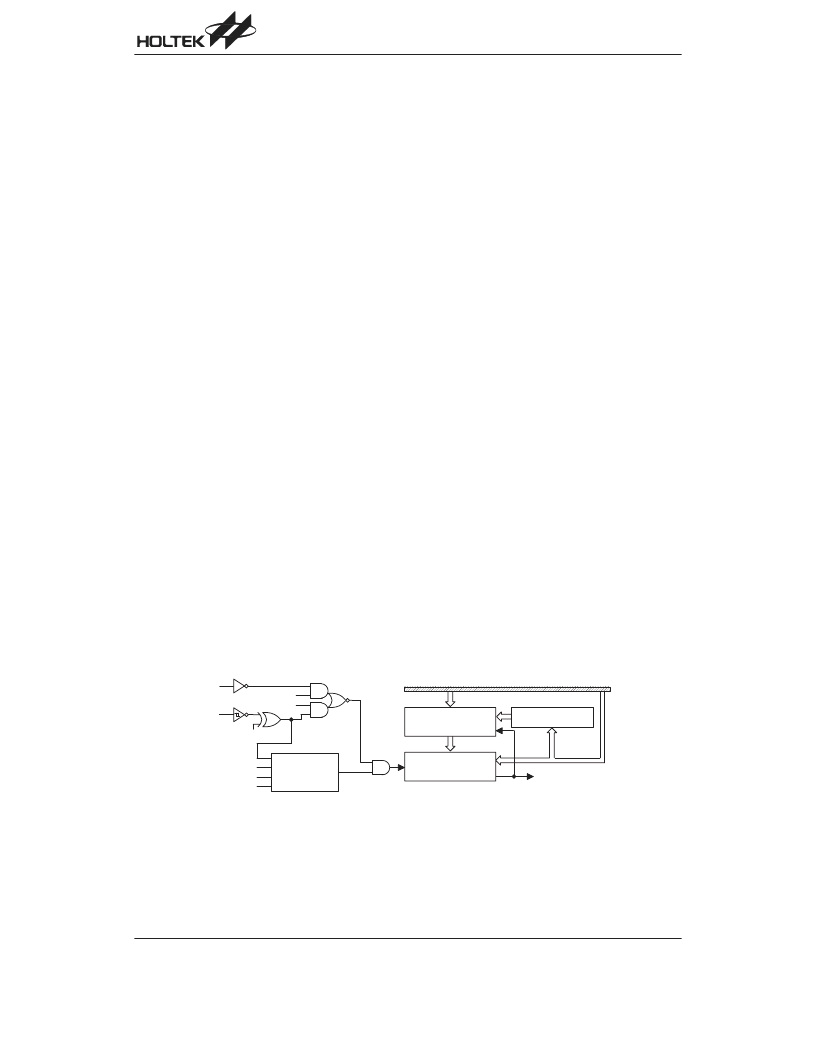- 您現(xiàn)在的位置:買賣IC網(wǎng) > PDF目錄385399 > HT46C63-56SSOP-A (Holtek Semiconductor Inc.) A/D with LCD Type 8-Bit MCU PDF資料下載
參數(shù)資料
| 型號: | HT46C63-56SSOP-A |
| 廠商: | Holtek Semiconductor Inc. |
| 英文描述: | A/D with LCD Type 8-Bit MCU |
| 中文描述: | 在A / D液晶型8位微控制器 |
| 文件頁數(shù): | 17/44頁 |
| 文件大?。?/td> | 328K |
| 代理商: | HT46C63-56SSOP-A |
第1頁第2頁第3頁第4頁第5頁第6頁第7頁第8頁第9頁第10頁第11頁第12頁第13頁第14頁第15頁第16頁當(dāng)前第17頁第18頁第19頁第20頁第21頁第22頁第23頁第24頁第25頁第26頁第27頁第28頁第29頁第30頁第31頁第32頁第33頁第34頁第35頁第36頁第37頁第38頁第39頁第40頁第41頁第42頁第43頁第44頁

HT46R63/HT46C63
Rev. 1.90
17
May 17, 2004
Timer/Event Counter
Atimer/event counter is implemented in the device. The
timer/event counter contains a 16-bit programmable
count-up counter and the clock may come from an ex-
ternal source or the internal clock source.
The internal clock source is the system clock divided by
4: f
SYS
/4. The external clock input allows the user to
count external events, measure time intervals or pulse
widths, or to generate an accurate time base.
There are 3 registers related to timer/event counter;
TMRH(0CH), TMRL(0DH), TMRC(0EH). Writing TMRL
only stores the data into a low byte buffer, and writing
TMRH will put the written data and the low contents of
low byte buffer to preload register (16 bits) simulta-
neously. The timer/event counter preload register is
changed by writing TMRH operations and writing TMRL
will keep the timer/event counter preload register un-
changed.
Reading TMRH will also latch the TMRL into the low
byte buffer to avoid the false timing problem. Reading
TMRL returns the contents of the low byte buffer. In
other words, the low byte of timer/event counter cannot
be read directly. It has to read the TMRH first to make
the low byte contents of timer/event counter latched into
the buffer. The TMRC is the timer/event counter control
register, which defines the operating mode, counting en-
able or disable and active edge.
The TM0, TM1 bits define the operating mode. The
event count mode is used to count external events,
which means the clock source comes from an external
(TMR) pin. The timer mode functions as a normal timer
with the clock source coming from f
SYS
/4. The pulse
width measurement mode can be used to count the high
or low level duration of the external signal (TMR). The
counting is based on f
SYS
/4.
In the event count or timer mode, once the timer/event
counter starts counting, it will count from the current
contents in the timer/event counter to FFFFH. Once
overflow occurs, the counter is reloaded from the
timer/event counter preload register and generates the
corresponding interrupt request flag (TF; bit 6 of INTC0)
at the same time.
In pulse width measurement mode with the TON and TE
bits are equal to one, once the TMR has received a tran-
sition from low to high (or high to low if the TE bit is 0) it
will start counting until the TMR returns to the original
level and reset the TON. The measured result will re-
main in the timer/event counter even if the activated
transition occurs again. In other words, only one cycle
measurement can be done. Until setting the TON, the
cycle measurement will function again as long as it re-
ceives further transition pulse. Note that, in this operat-
ing mode, the timer/event counter starts counting not
according to the logic level but according to the transi-
tion edges. In the case of counter overflows, the counter
is reloaded from the timer/event counter preload regis-
terandissuestheinterruptrequestjustliketheothertwo
modes.
Toenablethecountingoperation,thetimerONbit(TON;
bit 4 of TMRC) should be set to 1. In the pulse width
measurement mode, the TON will be cleared automati-
callyafterthemeasurementcycleiscomplete.Butinthe
other two modes the TON can only be reset by instruc-
tions. The overflow of the timer/event counter is one of
the wake-up sources. No matter what the operation
mode is, writing a 0 to ETI can disabled the correspond-
ing interrupt service.
In the case of timer/event counter OFF condition, writing
data to the timer/event counter preload register will also
load the data to timer/event counter. But if the
timer/event counter is turned on, data written to the
timer/event counter will only be kept in the timer/event
counter preload register. The timer/event counter will
still operate until the overflow occurs (a timer/event
counter reloading will occur at the same time).
6
! , - $
& 1 # 2
$
- ! $ $ " #
1 $
" #
,
4
& #
& $
$ + $ " #
1
! " # $
$ ,
$
& - # $
) 4
& #
*
:
> # $
!
$
#
! -
$ ,
1
4
& #
& $
$ + $ " #
! " # $
* 0
/
7 8
+ $
, :
#
" # $
! % #
Timer/Event Counter
相關(guān)PDF資料 |
PDF描述 |
|---|---|
| HT46R63 | A/D with LCD Type 8-Bit MCU |
| HT46C64 | A/D with LCD Type 8-Bit MCU |
| HT46R64 | A/D with LCD Type 8-Bit MCU |
| HT46R23 | 8-Bit OTP Microcontroller |
| HT46R47 | 8-Bit OTP Battery Charger Controller |
相關(guān)代理商/技術(shù)參數(shù) |
參數(shù)描述 |
|---|---|
| HT46C64 | 制造商:HOLTEK 制造商全稱:Holtek Semiconductor Inc 功能描述:A/D with LCD Type 8-Bit MCU |
| HT46C64_11 | 制造商:HOLTEK 制造商全稱:Holtek Semiconductor Inc 功能描述:A/D with LCD Type 8-Bit MCU |
| HT46C65 | 制造商:HOLTEK 制造商全稱:Holtek Semiconductor Inc 功能描述:A/D with LCD Type 8-Bit MCU |
| HT46C65_11 | 制造商:HOLTEK 制造商全稱:Holtek Semiconductor Inc 功能描述:A/D with LCD Type 8-Bit MCU |
| HT46C65-100 | 制造商:HOLTEK 制造商全稱:Holtek Semiconductor Inc 功能描述:A/D with LCD Type 8-Bit MCU |
發(fā)布緊急采購,3分鐘左右您將得到回復(fù)。